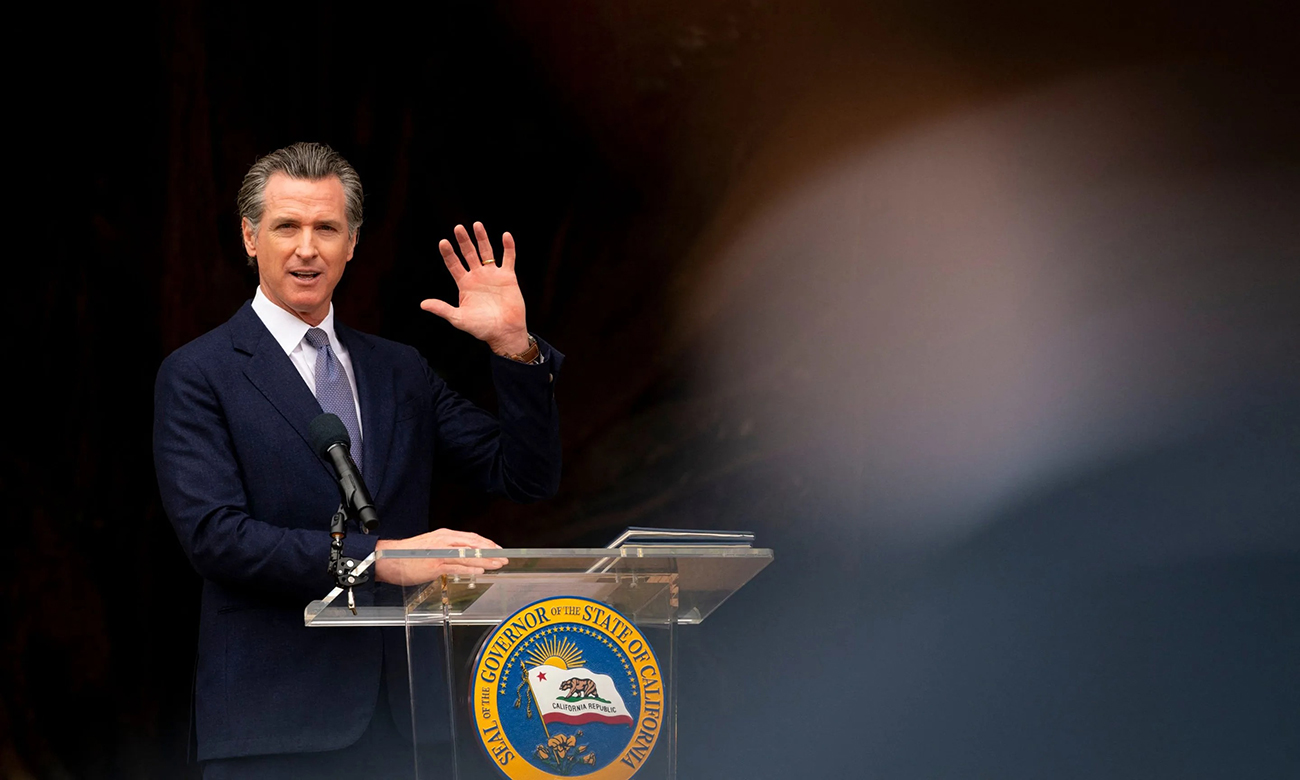加州正在以一己之力试图解决美国所有的经济问题。下一步:改变医药市场

今年7月初,美国加利福尼亚州的州长加文·纽森上了新闻头条,他宣布该州将向符合条件的居民发放最高1050美元的一次性支票,以帮助他们应对高油价和不断上升的通货膨胀率。
目前,这位州长正在为该州4000万居民中的许多人解决另外一个主要的经济问题。纽森于7月7日表示,该州将斥资1亿美元开始生产低成本胰岛素(糖尿病患者的救命药物),这可能会在此过程中颠覆医药市场。
该州计划拨款5000万美元资助加州的一家胰岛素制造工厂,而另外5000万美元将用于支付研发这种药物的费用。
“没有什么比胰岛素价格更能够体现市场失灵了。”这位民主党州长在他的推特(Twitter)主页上发布的一段视频声明中说。“加州现在正着手解决这一问题……我们认为人们不应该为了获得救命药物而负债。”
胰岛素在美国价格高昂、成本高昂
克雷格·斯图宾患有1型糖尿病,他担任一档关于糖尿病患者如何进行生活管理的播客的主持人,他告诉《财富》杂志,胰岛素价格上涨在某种程度上已经成为“近年来大型制药公司价格欺诈的典型案例”。
在美国,胰岛素的价格比其他发达经济体高出约800%。根据2019年发表在医学杂志《美国医学会内科医学期刊》(JAMA Internal Medicine)上的一项研究,大约四分之一的糖尿病患者被迫定量配给或跳过剂量。根据《美国医学会杂志》(JAMA)的研究,黑人、拉丁裔和美国原住民患者受到的影响更大,因为他们更有可能参保不足或未参保。
虽然目前尚不清楚美国有多少糖尿病患者的直接死因是缺乏胰岛素,但《财富》杂志在2021年查阅的数据表明,每天至少有几个人死于缺乏胰岛素。
2021年,连续第二年有超过10万美国人死于糖尿病,部分原因是胰岛素价格飙升——90%的胰岛素由三家公司供应。
加州约有320万人被诊断出患有糖尿病,占成年人口的10.5%。根据美国糖尿病协会(American Diabetes Association)的数据,2017年,该州因为糖尿病而产生的直接医疗费用总额估计为270亿美元,而且自那以后费用可能会进一步增加。
耶鲁大学医学院(Yale University School of Medicines)的儿科内分泌科(Division of Pediatric Endocrinology)的助理儿科教授劳拉·纳利博士在接受《财富》杂志采访时称:“在过去的几十年里,就同样的胰岛素、同样的药物来说,胰岛素的价格已经从每瓶21美元左右涨到了每瓶300美元以上。加州着手解决这一问题迈出了该领域的一大步。”
制药业面临的重大挑战
专家告诉《财富》杂志,加州的人口规模及其以低成本生产胰岛素的决定,可能会成为促使全国范围内胰岛素价格下降的催化剂,并可能给制药公司施加压力,迫使它们降低价格。
为1型糖尿病患者提供服务的非营利倡导组织T-1 International的政策经理谢娜·卡斯珀告诉《财富》杂志:“为生产胰岛素(和其他基本药物)创造的公共能力,将开始改变迄今为止阻碍胰岛素定价进展的局面。”
加州的低成本胰岛素何时可以上市,目前尚未公布时间表。但医疗保健倡导者表示,他们希望加州成为其他州采取类似行动或让联邦政府采取更多措施控制胰岛素价格的典范。
总部位于华盛顿特区的研究收入不平等问题的研究中心Democracy Collaborative的健康与经济主管达纳·布朗告诉《财富》杂志:“药品的公有制能够成为我们控制药品价格所需设计的工具。为了得到不同的结果,我们需要不同的设计。这就是加州计划在公共部门生产胰岛素等基本药物的举措令人兴奋的地方。”
美国总统乔·拜登于去年11月在众议院通过的《重建美好的未来法案》(Build Back Better Act),实际上在参议院被否决了。该法案包括一项规定,将自费购买胰岛素的费用限制在每月35美元。
今年6月,新罕布什尔州民主党参议员珍妮·沙欣和缅因州共和党参议员苏珊·柯林斯公布了一项两党法案,该法案同样将为参保患者和参加联邦医疗保险(Medicare)的患者设定每月35美元的胰岛素费用上限,但不确定该法案是否可以获得足够的共和党支持以通过投票。
“政府必须介入,帮助糖尿病患者继续获得这种救命药物。”纳利博士说。“障碍似乎在不断增加……而且无论是否有保险,获得胰岛素都变得越来越困难。”(财富中文网)
译者:中慧言-王芳
今年7月初,美国加利福尼亚州的州长加文·纽森上了新闻头条,他宣布该州将向符合条件的居民发放最高1050美元的一次性支票,以帮助他们应对高油价和不断上升的通货膨胀率。
目前,这位州长正在为该州4000万居民中的许多人解决另外一个主要的经济问题。纽森于7月7日表示,该州将斥资1亿美元开始生产低成本胰岛素(糖尿病患者的救命药物),这可能会在此过程中颠覆医药市场。
该州计划拨款5000万美元资助加州的一家胰岛素制造工厂,而另外5000万美元将用于支付研发这种药物的费用。
“没有什么比胰岛素价格更能够体现市场失灵了。”这位民主党州长在他的推特(Twitter)主页上发布的一段视频声明中说。“加州现在正着手解决这一问题……我们认为人们不应该为了获得救命药物而负债。”
胰岛素在美国价格高昂、成本高昂
克雷格·斯图宾患有1型糖尿病,他担任一档关于糖尿病患者如何进行生活管理的播客的主持人,他告诉《财富》杂志,胰岛素价格上涨在某种程度上已经成为“近年来大型制药公司价格欺诈的典型案例”。
在美国,胰岛素的价格比其他发达经济体高出约800%。根据2019年发表在医学杂志《美国医学会内科医学期刊》(JAMA Internal Medicine)上的一项研究,大约四分之一的糖尿病患者被迫定量配给或跳过剂量。根据《美国医学会杂志》(JAMA)的研究,黑人、拉丁裔和美国原住民患者受到的影响更大,因为他们更有可能参保不足或未参保。
虽然目前尚不清楚美国有多少糖尿病患者的直接死因是缺乏胰岛素,但《财富》杂志在2021年查阅的数据表明,每天至少有几个人死于缺乏胰岛素。
2021年,连续第二年有超过10万美国人死于糖尿病,部分原因是胰岛素价格飙升——90%的胰岛素由三家公司供应。
加州约有320万人被诊断出患有糖尿病,占成年人口的10.5%。根据美国糖尿病协会(American Diabetes Association)的数据,2017年,该州因为糖尿病而产生的直接医疗费用总额估计为270亿美元,而且自那以后费用可能会进一步增加。
耶鲁大学医学院(Yale University School of Medicines)的儿科内分泌科(Division of Pediatric Endocrinology)的助理儿科教授劳拉·纳利博士在接受《财富》杂志采访时称:“在过去的几十年里,就同样的胰岛素、同样的药物来说,胰岛素的价格已经从每瓶21美元左右涨到了每瓶300美元以上。加州着手解决这一问题迈出了该领域的一大步。”
制药业面临的重大挑战
专家告诉《财富》杂志,加州的人口规模及其以低成本生产胰岛素的决定,可能会成为促使全国范围内胰岛素价格下降的催化剂,并可能给制药公司施加压力,迫使它们降低价格。
为1型糖尿病患者提供服务的非营利倡导组织T-1 International的政策经理谢娜·卡斯珀告诉《财富》杂志:“为生产胰岛素(和其他基本药物)创造的公共能力,将开始改变迄今为止阻碍胰岛素定价进展的局面。”
加州的低成本胰岛素何时可以上市,目前尚未公布时间表。但医疗保健倡导者表示,他们希望加州成为其他州采取类似行动或让联邦政府采取更多措施控制胰岛素价格的典范。
总部位于华盛顿特区的研究收入不平等问题的研究中心Democracy Collaborative的健康与经济主管达纳·布朗告诉《财富》杂志:“药品的公有制能够成为我们控制药品价格所需设计的工具。为了得到不同的结果,我们需要不同的设计。这就是加州计划在公共部门生产胰岛素等基本药物的举措令人兴奋的地方。”
美国总统乔·拜登于去年11月在众议院通过的《重建美好的未来法案》(Build Back Better Act),实际上在参议院被否决了。该法案包括一项规定,将自费购买胰岛素的费用限制在每月35美元。
今年6月,新罕布什尔州民主党参议员珍妮·沙欣和缅因州共和党参议员苏珊·柯林斯公布了一项两党法案,该法案同样将为参保患者和参加联邦医疗保险(Medicare)的患者设定每月35美元的胰岛素费用上限,但不确定该法案是否可以获得足够的共和党支持以通过投票。
“政府必须介入,帮助糖尿病患者继续获得这种救命药物。”纳利博士说。“障碍似乎在不断增加……而且无论是否有保险,获得胰岛素都变得越来越困难。”(财富中文网)
译者:中慧言-王芳
In early July, California Gov. Gavin Newsom made headlines when he announced his state would be sending out one-time-only checks of up to $1,050 to qualifying residents to help battle high gas prices and rising inflation.
Now, the governor is tackling another major economic issue for many of California’s 40 million residents. Newsom said on July 7 that the state will spend $100 million to begin manufacturing its own low-cost insulin, the life-saving diabetes medication, possibly upending the pharmaceutical market in the process.
The state plans to direct $50 million towards funding an insulin manufacturing facility in California, while the other $50 million will be spent to cover the cost of developing the drug.
“Nothing epitomized market failures more than the cost of insulin,” the Democratic governor said in a video announcement posted to his Twitter page. “California is now taking matters into its own hands…we know people should not go into debt to receive life-saving medication.”
The high price and heavy cost of insulin in the U.S.
The rising cost of insulin has become “something of a poster child for Big Pharma’s price gouging in recent years,” Craig Stubing, who has Type-1 diabetes and hosts a podcast about managing life as a diabetic, told Fortune.
In the U.S., insulin is priced roughly 800% higher than it is in other developed economies. As a result, roughly 1 in 4 people with diabetes are forced to ration or skip doses, according to a 2019 study published in the medical journal JAMA Internal Medicine. Black, Latino and Native American patients are even more affected because they are more likely to be underinsured or uninsured, according to the JAMA study.
While it’s unclear how many diabetics die directly due to a lack of insulin in the U.S., data reviewed by Fortune in 2021 suggests it’s at least a few people per day.
More than 100,000 Americans died from diabetes for the second straight year in 2021, in part because of insulin’s soaring costs—90% of which is supplied by three companies.
Around 3.2 million people, or 10.5% of the California's adult population have been diagnosed with diabetes. Total direct medical expenses from the disease were estimated to be at $27 billion in the state in 2017, and have likely only grown since then, according to the American Diabetes Association (ADA).
“Over the last few decades, the price of insulin has increased from about $21 a vial, to over $300 a vial, for the exact same insulin, the exact same medication,” Dr. Laura Nally, Assistant Professor of Pediatrics at Yale University School of Medicines’ Division of Pediatric Endocrinology told Fortune. “What’s happening in California is a great step.”
A major challenge to the pharmaceutical industry
The size of California's population, and its decision to make insulin at low cost, could be a catalyst for insulin costs to drop nationwide, experts told Fortune, and could put pressure on pharmaceutical companies to lower their prices.
“Creating public capacity for the production of insulin (and other essential medicines) would begin to transform the landscape which has effectively prevented progress on insulin pricing up until now,” Shaina Kasper, Policy Manager at T-1 International, a non-profit advocacy group for people living with Type-1 diabetes, told Fortune.
No timeline has been announced as to when Californians can expect the state’s low-cost insulin to hit the market. But health care advocates say they hope California becomes a model for other states to take similar action, or for the federal government to do more to control the price of insulin.
“Public ownership in pharmaceuticals can be a vehicle for the designs we need to rein-in drug prices,” Dana Brown, Director of Health and Economy at the Democracy Collaborative, a D.C.-based research center focused on income inequality, told Fortune. “To get different outcomes, we need a different design. And that’s what’s so exciting about initiatives to produce essential medicines, like insulin, in the public sector as California is planning to do.”
President Joe Biden’s Build Back Better Act, which passed in the House last November but effectively died in the Senate, included a provision that would limit the out-of-pocket copay cost of insulin to $35 a month.
In June, Sens. Jeanne Shaheen, D-N.H., and Susan Collins, R-Maine, unveiled a bipartisan bill that would similarly place a $35 monthly cap on the cost of insulin for insured patients and those enrolled in Medicare, though it’s uncertain the bill has enough Republican support to make it past a vote.
“The government has to step in to help people with diabetes continue to access this life-saving medication,” Dr. Nally said. “The barriers seem to be increasing constantly…and it’s becoming increasingly difficult to access insulin regardless of insurance status.”













